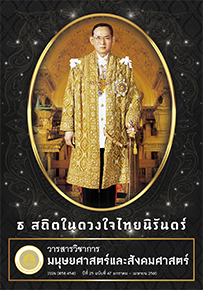รูปเคารพขนาดใหญ่มหึมาทางศาสนา: การเปลี่ยนแปลง กระบวนการสร้างความหมาย และภาพสะท้อนสังคมไทย Huge Religious Object of Worship: Change, Signification Creation and Reflection on Thai Society
Main Article Content
Abstract
บทคัดย่อ
งานวิจัยนี้ใช้วิธีการวิจัยเชิงคุณภาพ มีวัตถุประสงค์เพื่อ 1) ศึกษาการเปลี่ยนแปลงการสร้างรูปเคารพขนาดใหญ่มหึมาทางศาสนาในสังคมไทย 2) ศึกษากระบวนการสร้างความหมายของรูปเคารพขนาดใหญ่มหึมาทางศาสนา ร่วมกับพิธีกรรม และบุคคล 3) ศึกษาภาพสะท้อนสังคมไทย ด้านความเชื่อ ค่านิยม พื้นที่ทางสังคม ความปรารถนาของคนและการพาณิชย์ ศึกษาจากกลุ่มตัวอย่างเลือกแบบเจาะจง 9 แห่ง ใช้การวิเคราะห์เอกสาร ร่วมกับการสังเกตปรากฏการณ์ และสัมภาษณ์ผู้เกี่ยวข้อง รวบรวมข้อมูล นำเสนอแบบพรรณนาวิเคราะห์ พิจารณาข้อมูล 3 ด้าน คือ ด้านรูปเคารพ ด้านพิธีกรรม และด้านบุคคล ซึ่งทั้งสามด้านมีความสัมพันธ์สนับสนุนซึ่งกันและกัน ให้สังคมยอมรับการมีตัวตนของรูปเคารพอย่างยั่งยืน พบว่าการเปลี่ยนแปลง และกระบวนการสร้างความหมายในปัจจุบัน คือ รูปแบบของรูปเคารพมีความหลากหลายมากขึ้น ได้แก่ พระพุทธรูป เทวรูป และรูปเหมือนพระภิกษุสงฆ์ แสดงถึงการยอมรับยกย่องศาสนาพุทธ ศาสนาพราหมณ์-ฮินดู และผี (บรรพบุรุษ) ให้มีสถานภาพที่เท่าเทียมกัน หรือบางแห่งมากกว่าพระพุทธรูป และมีการใส่ความเป็นตัวตนของผู้อำนวยการสร้างหลักให้เป็นส่วนหนึ่งของรูปเคารพผ่านขนาดสัดส่วนของรูปเคารพไว้อย่างแยบยล โดยการผสานรวมแสดงถึงสถานภาพความเหมาะสมอย่างมีนัย
Abstract
This qualitative research is conducted with three objectives: 1) to study the change in the creation of huge religious objects of worship in Thai society, 2) to study the signification of huge religious object of worship inrelation to ritual and person, and 3) to examine Thai society through the lenses of belief, value, standpoint, people’s wish, and commerce. The samples, which are derived from purposive sampling, are consisted of huge religious objects of worship in 9 different places. Documentary analysis, observation, and interview are used for data collection, and the findings are presented in form of descriptive analysis. Three elements are considered: the object of worship, ritual, and person because these three elements are supportively interrelated which facilitates sustainability of the objects of worship. It is found that the changes and the signification of the objects of worship, nowadays, are that they are made in more various forms such as Buddha image, image of deity, and Buddhist monk figure. This reflects the equal significance among Buddhism, Hinduism, and spiritualism (progenitors’ spirit). In some places, the significance of the latter two is greater than that of Buddhism. The identity of the chair of founding ceremony is wisely amalgamated into the object of worship through the size and figure of the objects of worship.
Downloads
Article Details
บทความทุกบทความเป็นลิขสิทธิ์ของวารสารวิชาการมนุษยศาสตร์และสังคมศาสตร์ มหาวิทยาลัยบูรพาเท่านั้น


